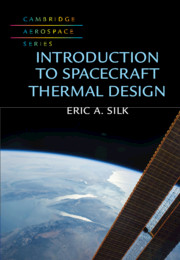Book contents
- Introduction to Spacecraft Thermal Design
- Cambridge Aerospace Series
- Introduction to Spacecraft Thermal Design
- Copyright page
- Dedication
- Contents
- Figures
- Tables
- Nomenclature
- Subscripts
- 1 Introduction
- 2 Conduction Heat Transfer Analysis
- 3 Radiative Heat Transfer Analysis
- 4 The Space Environment
- 5 Space-Based Advanced Thermal Conductance and Storage Technologies
- 6 Sensors, Instrumentation and Test Support Hardware
- 7 Fundamentals of Cryogenics
- 8 Developmental and Environmental Testing
- Book part
- Index
- Solutions
- References
1 - Introduction
Published online by Cambridge University Press: 19 June 2020
- Introduction to Spacecraft Thermal Design
- Cambridge Aerospace Series
- Introduction to Spacecraft Thermal Design
- Copyright page
- Dedication
- Contents
- Figures
- Tables
- Nomenclature
- Subscripts
- 1 Introduction
- 2 Conduction Heat Transfer Analysis
- 3 Radiative Heat Transfer Analysis
- 4 The Space Environment
- 5 Space-Based Advanced Thermal Conductance and Storage Technologies
- 6 Sensors, Instrumentation and Test Support Hardware
- 7 Fundamentals of Cryogenics
- 8 Developmental and Environmental Testing
- Book part
- Index
- Solutions
- References
Summary
Over the course of the past several years, I have had the opportunity to teach spacecraft thermal design to both undergraduate and graduate students. In researching texts for my first year of teaching the subject, I quickly found that there was no textbook available that methodically walked the student through the process of thermal design and analysis of space-based systems. Standard heat transfer texts simply did not provide detailed content addressing thermal design considerations and constructs for analysis of space-based systems: contemporary engineering texts only provided a cursory overview of space-based conduction and radiation phenomena. Texts that explicitly addressed the topic of spacecraft thermal design did so in the context of an overall systems perspective, with thermal as one of several chapters dedicated to different subsystems. Other chapters covered topics such as mechanical, guidance navigation and control, electrical, etc. Last but not least there was a lack of detailed treatment of techniques and methodologies developed from fundamental heat transfer, thermodynamics and fluid dynamics principles. In creating the lecture content for my course, I found this limited the conveyance of important subject matter to students. Ultimately, the solution for providing course participants with a coherent stream of lecture content was to combine information in previously published texts on the subject with information I deemed important. Information was collected in written form as class notes and provided to students as the primary text for the course. Ironically, while it is some years since I became a lecturer in aerospace, the absence of a single introductory text for students on spacecraft thermal design persists. Arguably, this is a key void in the literature associated with space systems. This volume aims to fill that void with teaching materials covering the topic of spacecraft thermal design. I hope that the concepts and principles conveyed in this book will inspire early-career practitioners and students enrolled in space-based courses, and enable them to gain a fundamental understanding of the thermal environment in space, as well as the basic skills required to perform spacecraft thermal design and analysis.
- Type
- Chapter
- Information
- Introduction to Spacecraft Thermal Design , pp. 1 - 12Publisher: Cambridge University PressPrint publication year: 2020



